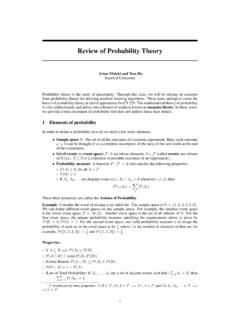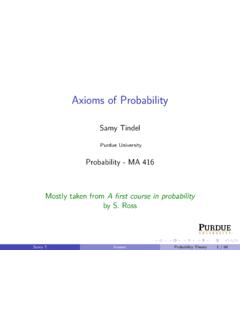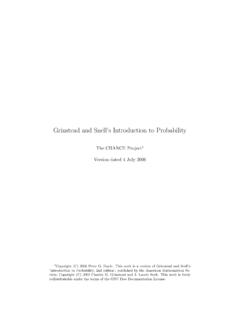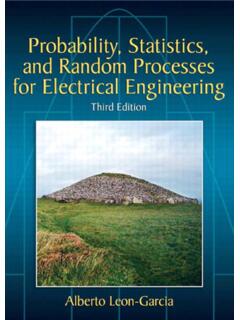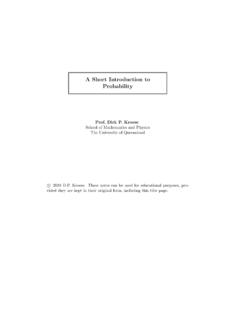Transcription of 7 Probability Theory and Statistics - Harvard University
1 7. Probability Theory and Statistics . In the last chapter we made the transition from discussing information which is considered to be error free to dealing with data that contained intrinsic errors. In the case of the former, uncertainties in the results of our analysis resulted from the failure of the approximation formula to match the given data and from round-off error incurred during calculation. Uncertainties resulting from these sources will always be present, but in addition, the basic data itself may also contain errors. Since all data relating to the real world will have such errors, this is by far the more common situation.
2 In this chapter we will consider the implications of dealing with data from the real world in more detail. 197. Numerical Methods and Data Analysis Philosophers divide data into at least two different categories, observational, historical, or empirical data and experimental data. Observational or historical data is, by its very nature, non-repeatable. Experimental data results from processes that, in principle, can be repeated. Some1 have introduced a third type of data labeled hypothetical-observational data, which is based on a combination of observation and information supplied by Theory . An example of such data might be the distance to the Andromeda galaxy since a direct measurement of that quantity has yet to be made and must be deduced from other aspects of the physical world.
3 However, in the last analysis, this is true of all observations of the world. Even the determination of repeatable, experimental data relies on agreed conventions of measurement for its unique interpretation. In addition, one may validly ask to what extent an experiment is precisely repeatable. Is there a fundamental difference between an experiment, which can be repeated and successive observations of a phenomenon that apparently doesn't change? The only difference would appear to be that the scientist has the option in the case of the former in repeating the experiment, while in the latter case he or she is at the mercy of nature.
4 Does this constitute a fundamental difference between the sciences? The hard sciences such as physics and chemistry have the luxury of being able to repeat experiments holding important variables constant, thereby lending a certain level of certainty to the outcome. Disciplines such as Sociology, Economics and Politics that deal with the human condition generally preclude experiment and thus must rely upon observation and "historical experiments" not generally designed to test scientific hypotheses. Between these two extremes are sciences such as Geology and Astronomy which rely largely upon observation but are founded directly upon the experimental sciences.
5 However, all sciences have in common the gathering of data about the real world. To the analyst, there is little difference in this data. Both experimental and observational data contain intrinsic errors whose effect on the sought for description of the world must be understood. However, there is a major difference between the physical sciences and many of the social sciences and that has to do with the notion of cause and effect. Perhaps the most important concept driving the physical sciences is the notion of causality. That is the physical biological, and to some extent the behavioral sciences, have a clear notion that event A causes event B.
6 Thus, in testing a hypothesis, it is always clear which variables are to be regarded as the dependant variables and which are to be considered the independent variables. However, there are many problems in the social sciences where this luxury is not present. Indeed, it may often be the case that it is not clear which variables used to describe a complex phenomenon are even related. We shall see in the final chapter that even here there are some analytical techniques that can be useful in deciding which variables are possibly related. However, we shall also see that these tests do not prove cause and effect, rather they simply suggest where the investigator should look for causal relationships.
7 In general data analysis may guide an investigator, but cannot substitute for his or her insight and understanding of the phenomena under investigation. During the last two centuries a steadily increasing interest has developed in the treatment of large quantities of data all representing or relating to a much smaller set of parameters. How should these data be combined to yield the "best" value of the smaller set of parameters? In the twentieth century our ability to collect data has grown enormously, to the point where collating and synthesizing that data has become a scholarly discipline in itself. Many academic institutions now have an entire department or an academic unit devoted to this study known as Statistics .
8 The term Statistics has become almost generic in the language as it can stand for a number of rather different concepts. Occasionally the collected data itself can be referred to as Statistics . Most have heard the reference to reckless operation of a motor vehicle leading to the operator "becoming a statistic". As we shall see, some of the quantities that we will develop to represent large 198. 7 - Probability Theory and Statistics amounts of data or characteristics of that data are also called Statistics . Finally, the entire study of the analysis of large quantities of data is referred to as the study of Statistics .
9 The discipline of Statistics has occasionally been defined as providing a basis for decision-making on the basis of incomplete or imperfect data. The definition is not a bad one for it highlights the breadth of the discipline while emphasizing it primary function. Nearly all scientific enterprises require the investigator to make some sort of decisions and as any experimenter knows, the data is always less than perfect. The subject has its origins in the late 18th and early 19th century in astronomical problems studied by Gauss and Legendre. Now statistical analysis has spread to nearly every aspect of scholarly activity.
10 The developing tools of Statistics are used in the experimental and observational sciences to combine and analyze data to test theories of the physical world. The social and biological sciences have used Statistics to collate information about the inhabitants of the physical world with an eye to understanding their future behavior in terms of their past performance. The sampling of public opinion has become a driving influence for public policy in the country. While the market economies of the world are largely self-regulating, considerable effort is employed to "guide" these economies based on economic Theory and data concerning the performance of the economies.

